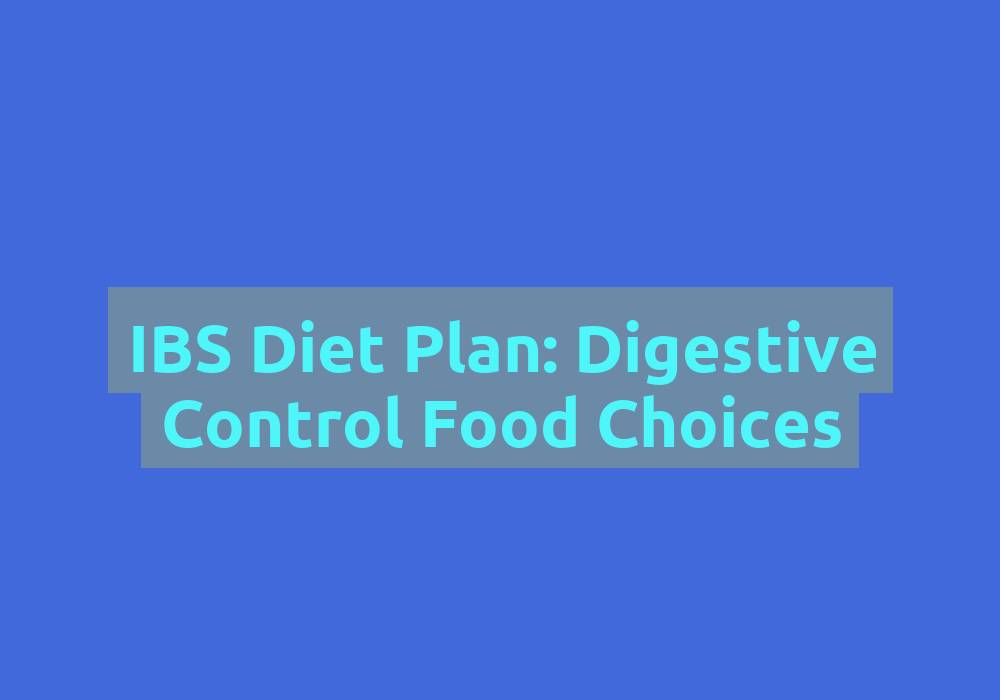IBS Diet Plan: Digestive Control Food Choices

Irritable Bowel Syndrome (IBS) is a common gastrointestinal disorder that affects the large intestine. Individuals with IBS often experience symptoms such as abdominal pain, bloating, constipation, and diarrhea. While there is no cure for IBS, managing the condition through dietary changes can significantly improve the quality of life for those affected. In this article, we will discuss an effective IBS diet plan that focuses on digestive control and food choices.
Understanding IBS Triggers
Before diving into the details of an IBS diet plan, it is crucial to understand the common triggers that can exacerbate symptoms. While these triggers may vary from person to person, some common culprits include:
-
FODMAPs: Fermentable Oligosaccharides, Disaccharides, Monosaccharides, and Polyols are a group of carbohydrates that are poorly absorbed in the small intestine. High FODMAP foods can lead to increased gas production and bloating in individuals with IBS. Some examples of high FODMAP foods to avoid are onions, garlic, wheat, milk, and certain fruits like apples and pears.
-
Gluten: Some individuals with IBS may experience sensitivity to gluten, a protein found in wheat, barley, and rye. Avoiding gluten-containing foods can alleviate symptoms. Gluten-free alternatives such as rice, corn, and quinoa can be included in the diet.
-
Dairy: Lactose, the sugar found in dairy products, can be difficult to digest for individuals with lactose intolerance. Limiting or eliminating dairy products may help reduce IBS symptoms. Lactose-free milk, almond milk, and other dairy alternatives can be used as substitutes.
-
High-fat foods: High-fat foods such as fried foods, fatty meats, and creamy sauces can contribute to diarrhea and abdominal pain in individuals with IBS. Choosing low-fat alternatives is recommended. Opt for lean meats, skinless poultry, and grilled or baked preparations instead of fried options.
The IBS Diet Plan
A well-planned IBS diet incorporates foods that promote healthy digestion while avoiding triggers that worsen symptoms. Here are some key principles to keep in mind:
1. Focus on Fiber
Fiber plays a crucial role in maintaining a healthy digestive system, but not all types of fiber are suitable for individuals with IBS. Soluble fiber is the best choice as it helps regulate bowel movements and can relieve both constipation and diarrhea. Good sources of soluble fiber include oats, brown rice, quinoa, bananas, berries, carrots, and potatoes. It’s important to note that consuming excessive amounts of fiber can worsen symptoms for some individuals. Gradually increase your fiber intake and monitor how your body responds.
In addition to soluble fiber, insoluble fiber can also be included in the diet. Insoluble fiber adds bulk to the stool and helps promote regular bowel movements. Some examples of foods high in insoluble fiber are whole grains, nuts, seeds, and leafy green vegetables.
2. Choose Low FODMAP Foods
Following a low FODMAP diet can significantly reduce IBS symptoms. The low FODMAP diet involves avoiding foods that are high in FODMAPs and gradually reintroducing them to identify personal triggers. Here are some examples of low FODMAP foods:
- Vegetables: spinach, kale, bell peppers, cucumber, zucchini
- Fruits: strawberries, blueberries, oranges, grapes, kiwi
- Proteins: chicken, turkey, fish, eggs, tofu
- Grains: gluten-free bread, rice, quinoa, oats
- Dairy alternatives: lactose-free milk, almond milk
It is important to note that the low FODMAP diet is not a long-term solution but rather a way to identify individual triggers. Consulting with a registered dietitian who specializes in the low FODMAP diet can provide personalized guidance and support.
3. Watch Portion Sizes
Portion control is essential for managing IBS symptoms. Eating smaller, more frequent meals throughout the day can help prevent overloading the digestive system. It is also important to eat slowly, chew food thoroughly, and avoid overeating. Including a variety of food groups in each meal can help ensure a balanced diet.
4. Stay Hydrated
Proper hydration is crucial for maintaining optimal digestive health. Drinking an adequate amount of water throughout the day can help prevent constipation and promote regular bowel movements. Avoiding excessive caffeine and alcohol consumption is also recommended, as they can have a diuretic effect and potentially worsen symptoms. Herbal teas and infused water can be refreshing alternatives to increase fluid intake.
5. Mindful Eating
Practicing mindful eating techniques can help individuals with IBS better manage their symptoms. This involves paying attention to hunger and fullness cues, eating in a calm environment, and avoiding distractions while eating. Stress and anxiety can worsen IBS symptoms, so incorporating stress-reducing activities such as deep breathing exercises or meditation can be beneficial. Taking the time to enjoy meals and savoring each bite can aid in digestion.
6. Keep a Food Diary
Keeping a food diary can help identify specific food triggers that worsen IBS symptoms. Record what you eat, when you eat it, and any symptoms experienced afterward. This information can be valuable when working with a healthcare professional or dietitian to fine-tune your diet plan. It can help identify patterns and make adjustments accordingly.
Conclusion
Creating an effective IBS diet plan requires a personalized approach that focuses on digestive control and food choices. By understanding common triggers, incorporating fiber-rich and low FODMAP foods, practicing portion control, staying hydrated, and adopting mindful eating habits, individuals with IBS can better manage their symptoms and improve their overall quality of life. Remember, it is essential to work closely with a healthcare professional or registered dietitian to develop a tailored IBS diet plan that suits your specific needs.
FAQ
Q1. What are some common triggers for IBS symptoms?
A1. Some common triggers for IBS symptoms include high FODMAP foods, gluten, dairy products, and high-fat foods.
Q2. What types of fiber are suitable for individuals with IBS?
A2. Soluble fiber is the best choice for individuals with IBS as it helps regulate bowel movements. Insoluble fiber can also be included in the diet to add bulk to the stool.
Q3. What are some low FODMAP foods that can be included in an IBS diet?
A3. Some examples of low FODMAP foods include spinach, kale, strawberries, blueberries, gluten-free bread, lactose-free milk, and chicken.
Q4. How can mindful eating techniques help manage IBS symptoms?
A4. Practicing mindful eating techniques such as paying attention to hunger and fullness cues, eating in a calm environment, and avoiding distractions can help individuals with IBS better manage their symptoms.
